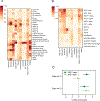High-throughput genetic clustering of type 2 diabetes loci reveals heterogeneous mechanistic pathways of metabolic disease
- PMID: 36538063
- PMCID: PMC10108373
- DOI: 10.1007/s00125-022-05848-6
High-throughput genetic clustering of type 2 diabetes loci reveals heterogeneous mechanistic pathways of metabolic disease
Abstract
Aims/hypothesis: Type 2 diabetes is highly polygenic and influenced by multiple biological pathways. Rapid expansion in the number of type 2 diabetes loci can be leveraged to identify such pathways.
Methods: We developed a high-throughput pipeline to enable clustering of type 2 diabetes loci based on variant-trait associations. Our pipeline extracted summary statistics from genome-wide association studies (GWAS) for type 2 diabetes and related traits to generate a matrix of 323 variants × 64 trait associations and applied Bayesian non-negative matrix factorisation (bNMF) to identify genetic components of type 2 diabetes. Epigenomic enrichment analysis was performed in 28 cell types and single pancreatic cells. We generated cluster-specific polygenic scores and performed regression analysis in an independent cohort (N=25,419) to assess for clinical relevance.
Results: We identified ten clusters of genetic loci, recapturing the five from our prior analysis as well as novel clusters related to beta cell dysfunction, pronounced insulin secretion, and levels of alkaline phosphatase, lipoprotein A and sex hormone-binding globulin. Four clusters related to mechanisms of insulin deficiency, five to insulin resistance and one had an unclear mechanism. The clusters displayed tissue-specific epigenomic enrichment, notably with the two beta cell clusters differentially enriched in functional and stressed pancreatic beta cell states. Additionally, cluster-specific polygenic scores were differentially associated with patient clinical characteristics and outcomes. The pipeline was applied to coronary artery disease and chronic kidney disease, identifying multiple overlapping clusters with type 2 diabetes.
Conclusions/interpretation: Our approach stratifies type 2 diabetes loci into physiologically interpretable genetic clusters associated with distinct tissues and clinical outcomes. The pipeline allows for efficient updating as additional GWAS become available and can be readily applied to other conditions, facilitating clinical translation of GWAS findings. Software to perform this clustering pipeline is freely available.
Keywords: Bayesian non-negative matrix factorisation; Clustering; Disease pathways; GWAS; Genetics; NMF; Polygenic risk scores; Subtypes; Type 2 diabetes; bNMF.
© 2022. The Author(s), under exclusive licence to Springer-Verlag GmbH Germany, part of Springer Nature.
Figures





